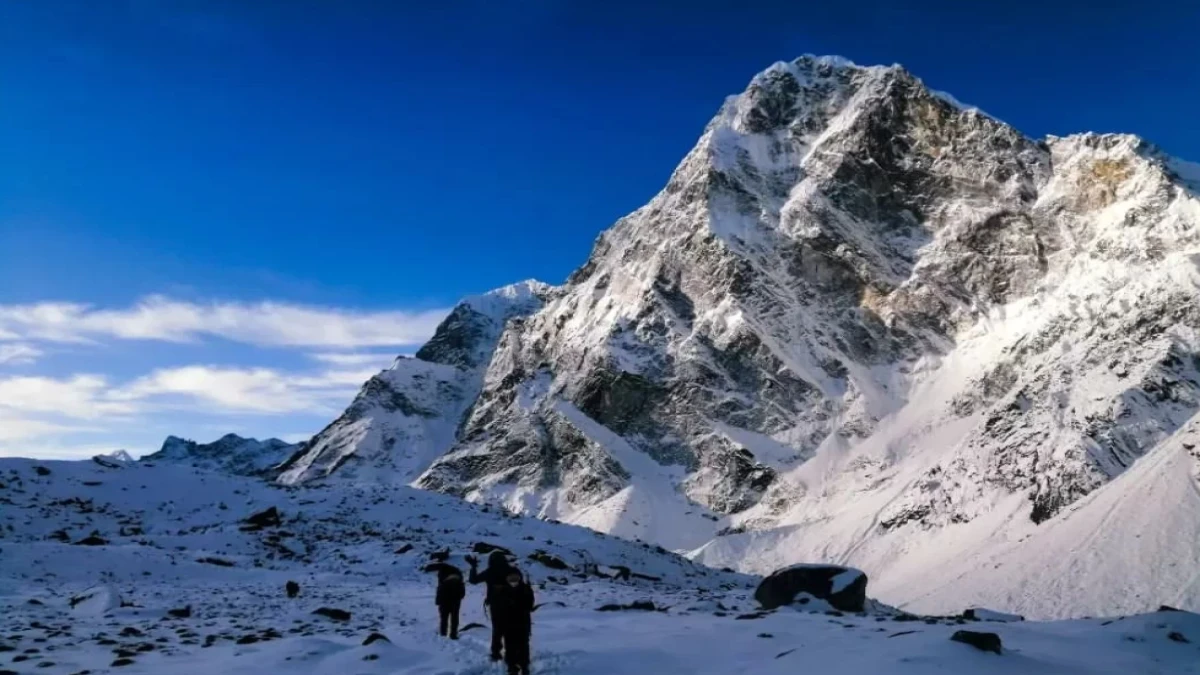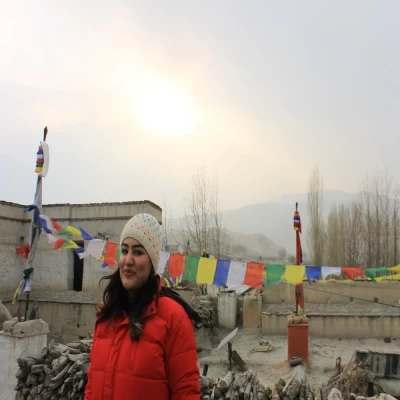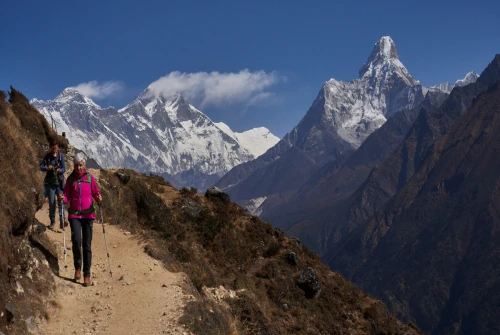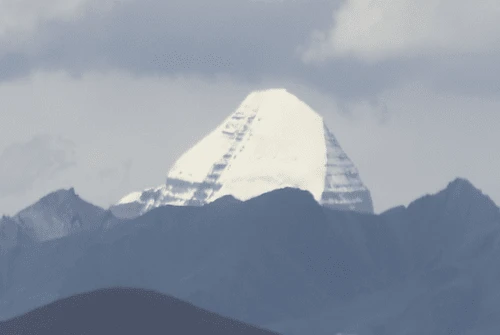Key Trek Information:
- Trek Duration: 16 Days
- Maximum Altitude: Kala Patthar (5,545m) / Cho La Pass (5,420m)
- Trek Difficulty: Challenging
- Best Suited For: Experienced trekkers, adventure seekers, high-altitude enthusiasts
- Region: Khumbu / Everest Region
This Gokyo Lake Cho La Pass and Everest Base Camp Trek is perfect for trekkers seeking a more adventurous and off-the-beaten-path experience in the Everest region. The dramatic mountain scenery, quiet Gokyo lakes, and the exhilaration of conquering the Cho La Pass create a lifetime memory for every traveler.
What Permits Are Required for the Gokyo Lake Cho La Pass via Everest Base Camp Trek?
Before embarking on the Gokyo Lake Cho La Pass via Everest Base Camp Trek, it’s crucial to obtain the correct trekking permits. These are mandatory for all foreign travelers hiking in the Everest region, and they ensure conservation support and trekker safety. Whether you’re planning a guided Everest Base Camp trek or an independent Gokyo Valley trek, these permits are essential. List of Required Permits for the Gokyo Lake Cho La Pass EBC Trek:
1. Sagarmatha National Park Entry Permit
- Cost: NPR 3,000 for foreigners / NPR 1,500 for SAARC nationals
- Where to get it: Nepal Tourism Board in Kathmandu or at the entry point in Monjo
- This permit is compulsory for entering Sagarmatha National Park, which encompasses Everest Base Camp, Gokyo Lakes, and Cho La Pass. As a UNESCO World Heritage Site, this park is home to incredible Himalayan flora, fauna, and some of the world’s highest trekking trails.
2. Khumbu Pasang Lhamu Rural Municipality Permit
- Cost: NPR 2,000 for foreigners / NPR 1,000 for SAARC nationals
- Where to get it: In Lukla or the Monjo checkpoint
- Replacing the TIMS card in this region, a local permit is required for all trekkers entering the Khumbu region. Funds from this permit directly support infrastructure and local development in villages like Namche Bazaar, Dingboche, Gokyo, and Dzongla.
3. TIMS Card (Trekkers’ Information Management System)
- NOT required for treks in the Everest region if you're going through a government-registered trekking agency.
- Independent trekkers also do not need a TIMS card here, as the Khumbu Rural Municipality handles their own trekker registration and safety system.
Gokyo Lake Cho La Pass Trek Permit Summary Table:
Permit Type | Cost (Foreigners) | Cost (SAARC) | Where to Get It |
Sagarmatha National Park Permit | NPR 3,000 | NPR 1,500 | Kathmandu or Monjo |
Khumbu Pasang Lhamu Rural Permit | NPR 2,000 | NPR 1,000 | Lukla or Monjo checkpoint |
TIMS Card | Not required | Not required | N/A |
Best Time to Do the Gokyo Lake Cho La Pass via Everest Base Camp Trek
The best time to undertake the Gokyo Lake Cho La Pass via Everest Base Camp Trek is during the spring (March to May) and autumn (September to November) seasons. These months offer the most stable weather, stunning visibility, and safer trail conditions especially important for navigating high-altitude sections like Cho La Pass (5,420m) and Kala Patthar (5,545m).
Spring in the Himalayas begins in March, with the cold of winter gradually retreating. Although early March may still have snow at higher altitudes, it is generally safe to trek. As you move into April, the weather becomes more pleasant, rhododendrons bloom along the trails, and skies are typically crystal clear, offering exceptional views of Everest, Lhotse, Makalu, and Cho Oyu. May brings warmer days, which makes trekking more comfortable, but visibility may start to decrease slightly toward the end of the month due to pre-monsoon haze.
Autumn, starting in September, follows the monsoon season. Early September may still see residual rainfall and cloud cover, but by mid-month, the skies begin to clear. October is the most popular and arguably the best month to trek this route. With crisp air, excellent mountain views, and dry trails, it’s ideal for crossing the Cho La Pass and enjoying panoramic viewpoints like Gokyo Ri and Kala Patthar. November remains clear but starts to get colder, especially at night. It's less crowded than October and still perfect for photography and scenic trekking.
The monsoon season (June to August) is not recommended for this trek. Heavy rainfall makes the trails muddy and dangerous, and flights to Lukla are often delayed or canceled. Visibility is poor, and the risk of landslides and floods is higher. Cho La Pass can be slippery and unsafe during this time.
Winter (December to February) brings extreme cold and heavy snowfall, particularly in high-altitude regions like Dzongla, Gokyo, and Cho La. While the lower parts of the trail remain open, the Cho La Pass is frequently blocked by snow, and many lodges close in the Gokyo Valley. Only highly experienced and well-equipped trekkers should consider winter attempts, and even then, success is weather-dependent.
What Is the Cost for the Gokyo Lake Cho La Pass EBC Trek?
The Gokyo Lake Cho La Pass Everest Base Camp trek is a stunning 16-day journey through some of Nepal’s most breathtaking landscapes. This trek combines the serene beauty of the Gokyo Lakes with the classic route to Everest Base Camp, crossing the challenging Cho La Pass at 5,420 meters. Because of its unique route and spectacular views, it is a popular choice for adventurous trekkers seeking both natural beauty and a rewarding challenge.
When it comes to the cost, the price for this 16-day trek typically ranges from $1,300 to $2,000 USD per person. The exact cost varies depending on several factors, including whether you choose a group or private trek, the level of services included, and the type of accommodation you prefer. Most trekking packages cover essential expenses such as domestic flights between Kathmandu and Lukla, trekking permits including TIMS and Sagarmatha National Park fees, meals and accommodation in tea houses along the trail, and the services of an experienced guide and porter.
However, it’s important to note that some costs are usually excluded from the package price. International airfare to Nepal, visa fees, personal expenses like snacks and souvenirs, travel insurance, and tips for guides and porters generally fall outside the base cost. These extra expenses should be factored into your overall trekking budget.
Choosing this trek means you’ll experience the best of both worlds, the peaceful turquoise Gokyo Lakes and the iconic Everest Base Camp. Crossing the Cho La Pass is a thrilling highlight that connects these two worlds, offering panoramic Himalayan views that few other treks can match. While the cost might be higher than some standard treks, many consider it a worthwhile investment for the unforgettable landscapes and cultural encounters along the way.
In summary, the Gokyo Lake Cho La Pass Everest Base Camp trek offers excellent value for money considering the included services, breathtaking scenery, and unique trekking experience. If you’re planning your Nepal trekking adventure in 2025 or 2026, budgeting around $1,300 to $2,000 USD for this 16-day trek is a good estimate to keep in mind.
Packing List for a Perfect Gokyo Lake Cho La Pass EBC Trek
For a successful and comfortable 16-day trek across the stunning Gokyo Lakes, Cho La Pass, and Everest Base Camp, packing the right gear is essential. Here’s what you should bring or you can rent
Clothing
- Thermal base layers (top & bottom)
- Fleece or down jacket
- Waterproof outer shell (jacket + pants)
- Trekking pants and quick-dry shirts
- Warm hat and sun hat
- Gloves (liner + insulated)
- Buff or neck gaiter
Footwear
- High-ankle trekking boots (well broken-in)
- Camp sandals or lightweight shoes
- Woolen and synthetic socks
Gear
- Backpack (40–60L)
- Daypack (15–25L) for water, snacks, and camera
- Sleeping bag rated for -10°C to -20°C
- Trekking poles
- Headlamp with extra batteries
- Water bottles or a hydration system
- Water purification tablets or a filter
Miscellaneous
- Sunglasses (UV protected)
- Sunscreen and lip balm
- First aid kit with altitude sickness medication
- Wet wipes, hand sanitizer, toiletries
- Passport, trekking permits, and travel insurance copy
16-Day Itinerary: Gokyo Lake, Cho La Pass, Everest Base Camp Trek
Embarking on the Cho La Pass is an unforgettable journey through some of the most spectacular landscapes in the Himalayas. This 16-day trek combines the serene turquoise waters of the Gokyo Lakes with the iconic Everest Base Camp, offering adventurers breathtaking mountain views, challenging passes, and rich Sherpa culture along the way. Designed to include essential acclimatization days, this itinerary balances adventure with safety, allowing trekkers to gradually adjust to the high altitudes while experiencing the best of Nepal’s Everest region. Whether you’re an experienced trekker or a passionate traveler seeking a rewarding challenge, this route promises a once-in-a-lifetime Himalayan adventure.
Day 1: Arrival at Tribhuvan International Airport (TIA), Kathmandu. Rest and prepare for the trek.
Day 2: Fly from Kathmandu to Lukla (2,860m), then trek to Phakding (2,600m). The trek is about 8 km and takes 3 to 4 hours.
Day 3: Trek from Phakding to Namche Bazaar (3,440m). Expect 5 to 6 hours of trekking through scenic trails.
Day 4: Acclimatization and rest day in Namche Bazaar. Use this time to explore the village or hike to nearby viewpoints.
Day 5: Trek from Namche to Phortse (3,600m), which takes approximately 5 to 6 hours.
Day 6: Trek from Phortse Trenga to Machermo (4,450m), about 4 to 5 hours.
Day 7: Trek from Machermo to Gokyo (4,750m), roughly 4 to 5 hours on the trail.
Day 8: Early morning hike to Gokyo Peak (5,360m) for spectacular panoramic views, then descend to Dragnak (4,700m). The day involves 4 to 5 hours of trekking.
Day 9: Cross Cho La Pass (5,355m), one of the most challenging parts of the trek, then descend to Dzonglha (4,860m). This day requires 7 to 8 hours of trekking.
Day 10: Trek from Dzonglha to Lobuche (4,930m), a shorter 2 to 3 hour trek.
Day 11: Trek from Lobuche to Gorak Shep (5,140m), then onward to Everest Base Camp (5,364m). This day involves 6 to 7 hours of trekking.
Day 12: Early hike to Kala Patthar (5,545m) for sunrise views over Everest, followed by descent to Periche (4,350m). The trek will take about 6 to 7 hours.
Day 13: Trek from Periche back to Namche Bazaar (3,400m), a full day of about 6 to 7 hours.
Day 14: Trek from Namche to Lukla (2,800m), approximately 6 to 7 hours of trekking.
Day 15: Fly from Lukla to Kathmandu. Enjoy a farewell dinner to celebrate your trek.
Day 16: Departure from Kathmandu or join another program.
Which Mountains Can You See During the Gokyo Lake Cho La Pass EBC Trek?
One of the highlights of the Gokyo Lake Cho La Pass Everest Base Camp trek is the incredible mountain scenery. Trekkers are treated to breathtaking panoramas of some of the world’s highest and most famous peaks.
From vantage points like Kala Patthar and Gokyo Ri, you’ll get magnificent views of:
- Mount Everest (8,848m) — the tallest peak on Earth
- Lhotse (8,516m) — the world’s 4th highest mountain
- Makalu (8,485m) — the 5th highest peak globally
- Cho Oyu (8,188m) — the 6th highest mountain
- Ama Dablam (6,812m) — often called the most photogenic peak in the Himalayas
Besides these giants, you’ll also see impressive peaks like Taboche, Cholatse, Thamserku, Nuptse, and Pumori, which form a dramatic backdrop to the trek.
Particularly, Gokyo Ri offers a stunning 360-degree panoramic view that encompasses the entire Everest massif, the shimmering Gokyo Lakes, and the vast Ngozumpa Glacier the longest glacier in Nepal. This spectacular sight is one of the many unforgettable experiences on this trek.
Accommodation and Food During the Gokyo Lake Cho La Pass Everest Base Camp Trek
Accommodation: Comfort in the Himalayas
The Gokyo Lake Cho La Pass trek offers a variety of tea houses and lodges that provide basic but cozy accommodation throughout the route. Most rooms are twin-sharing with simple beds and blankets some even provide mattresses and pillows, but bringing a lightweight sleeping bag liner can add extra warmth and comfort, especially in higher altitudes.
In lower villages like Phakding and Namche Bazaar, many tea houses have attached bathrooms, while higher up near Gokyo, Cho La Pass, and Everest Base Camp, facilities become more rustic, often shared and occasionally basic pit toilets. Hot showers are a luxury and usually available only in larger villages or for an additional fee, so it’s wise to prepare for cold showers or use wet wipes.
Many lodges offer charging stations and Wi-Fi, but these come at extra cost and can be unreliable depending on weather and power supply, so bring a power bank as backup.
Pro Tip: Book your tea house stays in advance during peak trekking seasons (spring and autumn), or start early to secure the best spots, as accommodations fill quickly.
Food: Fueling Your Trekking Adventure
Food along the trail is hearty and designed to fuel long days of trekking at high altitude. The classic Nepali meal is Dal Bhat, a combination of steamed rice, lentil soup, vegetable curry, and sometimes meat curry. It’s nutritious, affordable, and widely available.
Beyond Dal Bhat, tea houses serve a variety of international and Tibetan-inspired dishes to cater to diverse palates. Expect to find:
Momos (steamed or fried Tibetan dumplings filled with vegetables, chicken, or yak meat)
Pasta and noodles like chow mein and spaghetti
Soups and stews to warm you up on chilly evenings
Breakfast staples such as pancakes, porridge, eggs, and Tibetan bread (balep) provide energy to start the day right.
Warm drinks are essential at high altitudes. Along the trail, you’ll enjoy a variety of beverages like ginger tea, lemon tea, milk tea, and even hot chocolate perfect for soothing tired muscles and cold fingers.
Health Tip: Always choose hot, freshly cooked meals and drink boiled or purified water. Avoid raw vegetables and street food to minimize the risk of stomach issues, which can hamper your trek.
Unique Experience: Meet Local Hosts
Some tea houses are family-run, offering a chance to experience Sherpa hospitality firsthand. Don’t hesitate to ask your hosts about traditional food, culture, and local stories it adds a rich cultural dimension to your trek beyond just the natural beauty.
Electricity and Wi-Fi on the Gokyo Lake Cho La Pass Everest Base Camp Trek
Electricity Availability
Electricity is generally available in most tea houses and lodges along the Gokyo Lake Cho La Pass EBC trek route, but it can be unpredictable and limited. Power is mostly supplied by local micro-hydro plants or solar panels. However, outages are common, especially during bad weather or in more remote areas like near Cho La Pass and Everest Base Camp.
Most lodges offer charging services for your devices, such as cameras, phones, and power banks. Expect to pay a small fee (usually around $1 to $3 USD per device or per hour of charging). It’s important to carry your own power bank and universal travel adapter to stay powered up throughout your trek.
Wi-Fi Connectivity
Wi-Fi access is available in many tea houses, particularly in larger villages like Namche Bazaar, Machermo, and Gokyo. However, the connection speed is often slow and unstable, and in remote areas, Wi-Fi might not be available at all.
Some lodges offer Wi-Fi for a small charge, which can vary depending on the location and season. If staying connected is crucial, consider purchasing a local SIM card with a data plan (from Kathmandu or Namche Bazaar) for better internet access on the go.
Tips for Staying Connected
- Carry a reliable power bank to charge devices during the day, especially on trekking days without access to electricity.
- Bring a universal adapter compatible with Nepal’s power sockets (mostly type C, D, and M).
- Limit video streaming or large downloads to conserve data and battery.
- Use offline maps and downloaded content to reduce the need for constant internet access.
- Embrace the digital detox opportunity, sometimes disconnecting lets you fully enjoy the stunning natural surroundings!
Conclusion
The Gokyo Lake Cho La Pass via Everest Base Camp trek stands as one of the most spectacular and comprehensive Himalayan adventures. It offers an incredible mix of vibrant Sherpa culture, lush alpine forests, challenging glacial crossings, and breathtaking views of four towering 8,000-meter peaks. While physically demanding, this trek rewards those who come well-prepared both mentally and physically with unforgettable landscapes and life-changing experiences.
Whether you seek the thrill of crossing a high-altitude pass or the serene beauty of turquoise glacial lakes reflecting majestic snow-capped mountains, the Gokyo Lake Cho La Pass EBC trek is truly a must-do for every avid adventurer’s bucket list.




